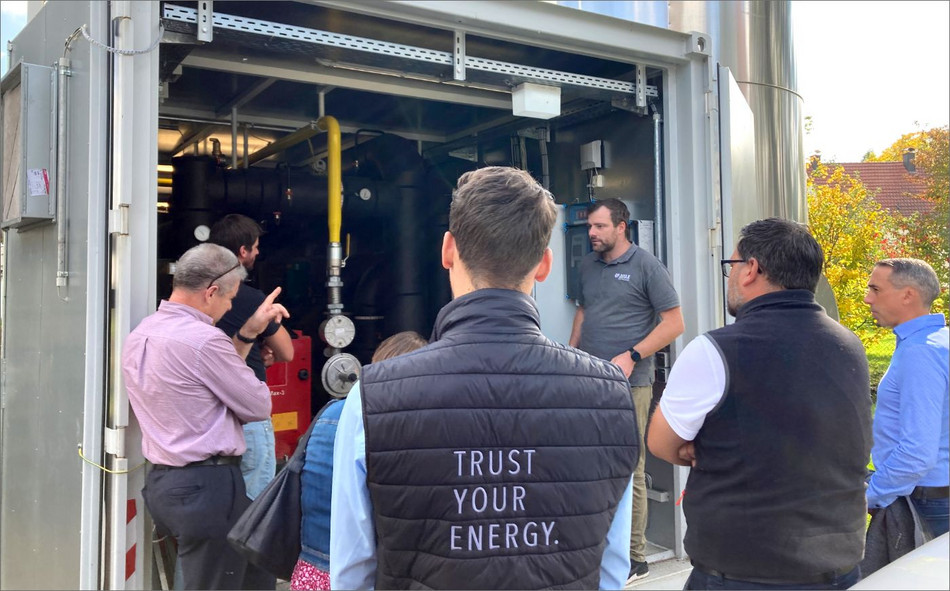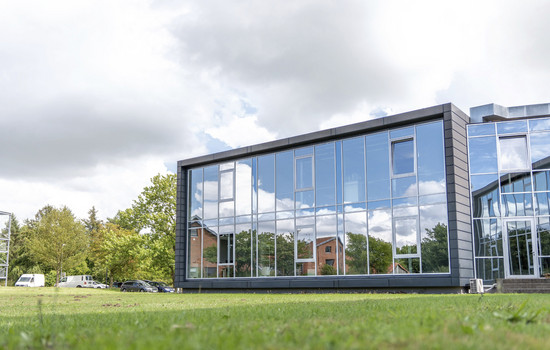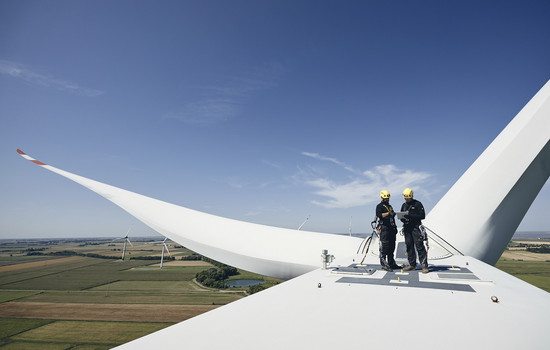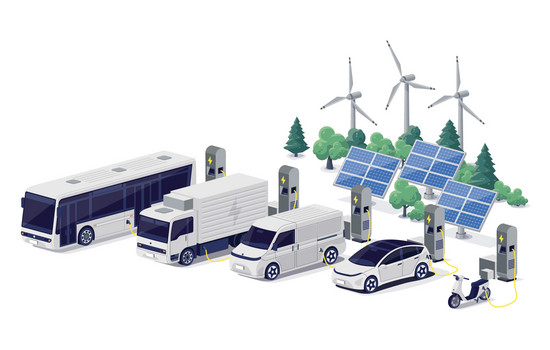Renewable heat from the network for the community
From the initial idea to commissioning: how municipalities plan, build and operate a local heating network

THE GP JOULE-MAGAZINE NR. 13 / NOVEMBER 2022
9 November 2022 is a watershed date for Tobias Kunz, Lord Mayor of Nordendorf. The municipal council will vote at their meeting today on a landmark policy decision: should a heating network be built in the Swabian village or not? Kunz himself sponsored the proposal. “The question arises for many citizens as well as our clubhouses as to what the future heating system will look like. Sooner or later, we will move towards renewable energies,” he says, explaining his push.
“There are two basic questions that need to be clarified first,” says Sören Haase, head of the heating network sales team at GP JOULE and the first point of contact for municipalities on the path to their own heating network. “Where do we get the heat from and where do we send the heat to?” GP JOULE’s heating team supports communities from the initial idea to ongoing operation and has the accumulated expertise from ten years of building renewable local heating networks.
There are a range of options for the heat sources. The first is to use waste heat from biogas plants or industrial processes. Using the heat from biogas plants is the option that was used in GP JOULE’s first heating networks, such as the one in Buttenwiesen. In the meantime, there has been a large increase in the number of wind turbines and their electricity surpluses can also be used. “This is mainly what is done with grids in northern Germany,” Haase reports. “If there is no existing heat source, we create one.” For example, GP JOULE relies on open-space photovoltaic systems for this in combination with an industrial-scale heat pump.
Meanwhile, in Nordendorf, Mayor Tobias Kunz has paved the way for the vote in the municipal council meeting. “We have held initial talks about land and talked to potential buyers,” he cites as examples of the preliminary work. Kunz is optimistic that the vote on the heating network will be positive: “Heat from renewable energy sources is the future. The demand is there and I’m sure the will of the board will be as well.”
The initial concept
Once the question of the heat source has been clarified, GP JOULE calculates how much heat can be generated per year and who the potential customers might be. “Municipal facilities such as schools, the town hall and nurseries are typically connected,” explains Haase. There are also commercial enterprises, perhaps also industrial companies and, of course, private households. With this in mind, the heating team checks, among other things, the density of development and when houses were built in streets in order to estimate the heat demand. “We will present the first rough concept to the mayor as well as the building committee.” The community representatives play a central role in developing a heating network. “If a mayor or the building committee chair is committed to it, it moves much faster,” Haase notes. Jörg Baumgärtner confirms this. He has been treasurer of the municipality of Mertingen and managing director of ProTherm Mertingen GmbH for 16 years.
“People know me. I am the one selling the heating network,” he says. Nevertheless, he sought out a cooperation with GP JOULE at that time. “We had no expertise in energy supply and needed a proven partner.” Sören Haase sums up that in the past, municipalities were approached proactively. “Increasingly, we find that communities are nowadays approaching us.”
On-site appointment with the heating network
This was also the case with Mayor Kunz from Nordendorf. He already knew about GP JOULE so went along to the presentation at the “Kommunale” trade fair in autumn 2020 in Nuremberg. In spring 2021, he invited Felix Schwahn, managing director of the heating division of GP JOULE, to a closed meeting at the municipal council. Kunz and his colleagues then travelled to Mertingen to hear an on-site explanation from Jörg Baumgärtner about the heating network. Other interested parties also come to the company’s Buttenwiesen headquarters to see heating networks that have already been implemented in the surrounding area and to talk to the local communities there. If the community agrees to it, the concept will be developed further. This stage already involves questions such as licence agreements for laying the pipes, who would build the solar park and who would operate the heating network. GP JOULE is founding a heating network company for the operation side of the equation. Municipalities can, for example, choose to take a 25 or 50 per cent stake in it, or GP JOULE can run it on its own. The Buttenwiesen municipality, where the heating network celebrated its 10th anniversary this year, has a stake in Renergiewerke Buttenwiesen GmbH. The same goes for Mertingen with ProTherm Mertingen GmbH.
Acquisition of heat consumers
Once the operating company has been established, the next step is to acquire customers. This calls for professional promotional materials, which are taken care of by another GP JOULE team. A website and brochures bundle information about the heating network and the connection options. GP JOULE is the direct contact for interested parties in this phase, makes home visits on request and answers questions from businesses and citizens. The municipal council in Zöschingen in the bavarian administrative district of Swabia voted unanimously in favour of a heating network at the beginning of April this year. After Renergiewerke Zöschingen GmbH was founded, the Lord Mayor Tobias Steinwinter and GP JOULE invited people to an information event in the community hall at the beginning of August 2022. “We introduced ourselves, the new operating company and the construction project, and explained how citizens will benefit from the heating network,” says Lena-Marie Brenner, who was on site as project manager. Out of 740 residents, 180 came to the information evening. Brenner is pleased with the huge level of interest, as there are a host of good reasons for a regeneratively powered heating network.
Property owners no longer have combustion processes in their houses and therefore do not need a chimney sweep, saving costs. There are no maintenance costs and they do not need to save for a new heating system. In addition, they do not need to worry about how they will achieve 65 per cent renewable energy in a new heating system, as stipulated by the Building Energy Act from 2024. They can also be assured of price stability when making plans. The heating contracts last for ten years. It is true that there the contract has a price escalation clause. “Our price adjustments move much more sluggishly than is the case with oil and gas though,” Haase emphasises.
For their part, municipalities invest long-term in their energy infrastructure, making a real contribution to climate protection. Cheap heat also strengthens the value of a community as a place to live or as somewhere for commercial and industrial enterprises.
Three connection options
Households who are interested can contact GP JOULE to arrange a personal appointment. The fine details can then all be discussed together around the kitchen table. Potential customers can choose from three options. Partial connection involves a pipe being laid on the property so they can be connected later. With the “grid connection” option, the local company lays the pipe up to the boiler room in the house. If the household or business then wants heat from the network, only the boiler needs to be replaced. If they choose a full connection, the heating system is replaced and the customer can get heat immediately. “We aim for a 50 per cent connection rate to move ahead,” Brenner reports. However, this is not a hard and fast figure. This is because one or two large consumers, for example from industry, can account for high heat consumption.
Once the sales team has reached the target connection rate and the heat demand has been determined, detailed planning is ramped up. Every single step in the construction project must now be broken down and costed. Heat sales manager Sören Haase gives some examples: the location of the heating centre is determined precisely and the technology required, right down to the pipes and screws, is laid out. Applications for permits, such as for constructing the heating centre, are submitted. If pipes have to be laid under roads, the team formalises road use contracts. The same applies to easements such as laying cables across fields where the solar park will be located. This phase takes about three to four months. When everything has been pulled together and current costings have been determined, GP JOULE updates the profitability calculation and makes the decision on construction within the operating company.
Secure funding
If it is to proceed, the next step is to take the business case to the bank. Financing is now negotiated based of the profitability projection including all costs and revenues. The bank takes signed heat purchase agreements as a form of collateral. “If the operating company is fully controlled by GP JOULE, the detailed planning and financing take place without involvement from the municipality. If the municipality is involved, it contributes part of the equity capital for the foundation of the company and also takes on some of the risk of implementation,” says Haase.
Once everything is in place, it’s time for implementation. Contractors come to lay the pipes and build the heating system. The goal in each project is to supply heat to about 30 to 40 customers as quickly as possible. That is why heating networks are built in stages. Haase knows from the experience of numerous projects: “It is very important to communicate well with everyone and to keep them informed in good time about when each construction phase will begin.” This is how the energy supply in a community is gradually converted to local heating.
There is still plenty the operating company has to do even after commissioning. “We take over technical management, carry out recurring maintenance, replace the calibrated heat meters at regular intervals and check the transfer stations,” says Benjamin Schwarz, project manager at GP JOULE for the Buttenwiesen heating network, citing a few examples. The company also prepares its annual accounts and deals with customer enquiries. Or there are new big projects coming up to take care of, as is the case in Mertingen.
In Mertingen in May 2022, treasurer Jörg Baumgärtner invited a group to the Wirtshaus Alte Brauerei guest house. He presented the planned expansion of the local heating network to around 60 property owners. It has been in operation since 2016, with heat being supplied by two biogas plants. A local dairy supplies residual materials and in turn gets waste heat itself for its production and administration. IN FOCUS Demand for new connections is steadily increasing. Areas are therefore now being sought to construct a solar park. This is to supply the energy for the large-scale heat pump and ultimately the grid. “We aim to have reached 100 per cent local heating supply within five years,” says Baumgärtner. GP JOULE’s heating team remains the point of contact and works hand in hand with GP JOULE’s own departments for planning, constructing and operating solar parks.
“We will then also be generating solar power for electric energy supply and electromobility at the same time,” Baumgärtner adds. The biggest challenge at the moment is to get reliable construction companies and building materials at affordable prices. There is no shortage of interest in connections. “To begin with, we offered the heat like cheap beer with an entry price of 8 cents per kilowatt hour. Our most important task now is to communicate that everyone will get their turn, but not immediately. With energy prices skyrocketing, everyone wants our heat.” The model for the land lease presented in the guest house convinces the citizens present. The expansion moves onto the planning stage.
In Nordendorf, the local council votes in favour of building the heating network on 9 November, giving the starting signal for the safe, regenerative future of heating.
![[Bitte in "English" übersetzen:] [Bitte in "English" übersetzen:]](/fileadmin/_processed_/8/9/csm_gp_jamesblog_14_7a870ae12b.jpg)




![[Bitte in "English" übersetzen:] [Bitte in "English" übersetzen:]](/fileadmin/_processed_/a/6/csm_GP_29.01.24_ZweiVonUns-Olaf_header_2d7a81f45d.jpg)